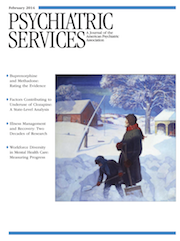Psychotropic Prescribing for Persons With Intellectual Disabilities and Other Psychiatric Disorders
Abstract
Objective
Prescribing patterns of psychotropic medication over a five-year period for Medicaid recipients (adults and children) with codiagnoses of an intellectual disability and a mental disorder were compared with patterns for those with sole mental disorder diagnoses.
Methods
Each group was identified through paid behavioral health services claims. Four classes of medications (antidepressants, antipsychotics, benzodiazepines, and mood stabilizers) were examined in paid pharmacy claims. Diagnostic categories, rates of psychotropic prescription, and polypharmacy (three or more medications concurrently for 90 days or more) were compared by age group (child or adult).
Results
Adults with mental disorders only (N=793 to 883; the range reflects the five study years) were prescribed antidepressants at a significantly higher rate compared with adults in the codiagnosis group (N=184 to 217). For three of the five study years, antipsychotics were prescribed to the sole-diagnosis group of adults at a significantly higher rate than to those with codiagnoses. Children in the group with codiagnoses (N=108 to141) were prescribed mood stabilizers at a significantly higher rate than the comparison group (N=638 to 728) in all five study years. Rates of antipsychotics prescribed were not statistically different between the two groups of children. Polypharmacy rates for both adults and children were higher for the codiagnosis group compared with the group with a sole mental disorder, but the difference did not reach statistical significance.
Conclusions
Psychotropic prescribing patterns in the two groups studied varied by class of medication and age. Although evidence exists for using psychotropics to treat psychopathology and challenging behaviors among individuals with intellectual disabilities, consideration of behavioral intervention alternatives and careful monitoring of psychotropic effectiveness and side effects are recommended.



